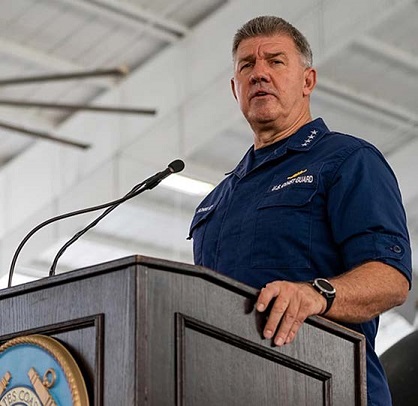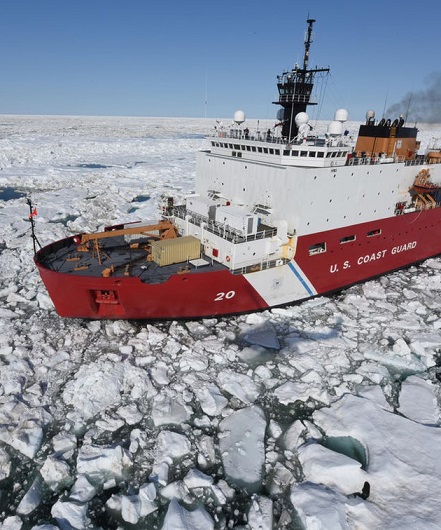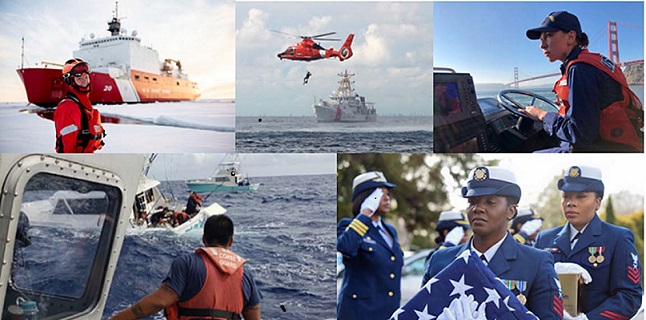
On Leading the U.S. Coast Guard

August 4th, 2021, marked the Coast Guard’s 231st birthday. Created by Congress as the Revenue-Marine on August 4, 1790, at the request of Alexander Hamilton, the Coast Guard is the oldest continuously operating naval service of the United States. In 1915, the Revenue Cutter Service merged with the U.S. Lifesaving Service and became the modern U.S. Coast Guard. As one of the country’s six armed services, the U.S. Coast Guard has been deployed to support and fight every major U.S. war since 1790. In 2003, the Coast Guard found its current home as a component of the U.S. Department of Homeland Security (DHS).
“As the twenty-sixth commandant of the Coast Guard,” explains Admiral Karl Schultz, “my guiding principles focus on ensuring our Service remains best positioned to ‘Stand the Watch.’ We serve a nation whose economic prosperity, national security, and global influence are inextricably linked to the maritime domain. Our Coast Guard is strong, the total workforce highly capable, and the demand for our services never greater.”
Admiral Schultz joined me on The Business of Government Hour to discuss the Coast Guard’s strategic direction, his key priorities and modernization efforts, and reflections on his tenure as the commandant. The following is an edited excerpt of our discussion, complemented with additional research and updating from Admiral Schultz’s State of the Coast Guard 2022 address.
On the Mission of the U.S. Coast Guard
We have eleven statutory missions, which conveys the complexity of the work we do. We are responsible for maritime safety, security, and environmental stewardship in U.S. ports and waterways. We have a unique dual mission, encompassing law enforcement and being part of the U.S. armed services. We have broad legal authorities associated with maritime transportation, hazardous materials shipping, bridge administration, oil spill response, pilotage, and vessel construction and operation.
The Coast Guard is a member of the national intelligence community as well. We do all this with a primary team of over 56,000, complemented by a truly valuable and unique cohort called the Coast Guard Auxiliary. We operate a fleet of over 200 cutters, over 240 fixed- and rotary-wing aircraft, and over 1,600 boats. There’s about $5.4 trillion in annual economic activity that comes in and out of our 360-plus ports, and our 25,000 miles of nautical waterways in the Marine Transportation System (MTS). Last year, our budget eclipsed $13 billion for the first time in our history.
On Building an Agile and Adaptive Force
We are an agile, adaptive force whose greatest value to our nation resides in our ability to rapidly shift our missions and efforts to meet national priorities during both steady state and crises. The agility, strength, and resilience of our 42,000-strong active-duty force continues to impress. But we could not have performed at the highest level—especially in times of crisis—if not for our reserve component and volunteer auxiliary.
Last fall, Coast Guard personnel supported thirteen contingency operations occurring simultaneously, on top of steady state business. In every major operation, reservists and auxiliarists were “United in Service,” meaning side-by-side with our full-time personnel. They were among one hundred medical personnel deployed to the Southwest border, supporting Customs and Border Protection operations and FEMA. They were also among the medical contingent who delivered CDC-recommended vaccines to Afghan nationals in support of DHS’s Operation Allies Welcome.
On Management Challenges
My first challenge is to make sure we have sufficient and, if possible, additional resources to meet our readiness challenges. We continue to make progress budget-wise with support from the Hill and the administration.
The second challenge involves operating in an increasingly competitive market for talent. From surveys, slightly north of 25 percent of America’s youth are eligible to serve in the armed forces. You look within that percentage and there’s about 10 percent with a propensity to serve. We’re trying to find 4,000 young men and women that want to serve in our enlisted workforce and trying to find about 500 officers. While we have the highest retention of any of the armed forces, we still need to attract men and women to lead the next generation of “Coasties.”
We’re focused on retaining our workforce by looking for opportunities—from childcare subsidies to expanded educational benefits—that will make the Coast Guard an employer of choice for a new generation of Americans. We’ve adopted a new blended retirement strategy. We work to attract technical specialists. A critical part of that effort is to continually increase the diversity of our service. Anything less means that we will fail to garner the talent, innovation, creativity, and performance necessary to meet the challenges of an increasingly complex maritime operating environment.
On the Pandemic Response
As the commandant, I am incredibly proud of our workforce and accomplishments. The Coast Guard entrusts and empowers its personnel at every level to lead with a bias for action—taking on-scene initiative and bringing solutions to complex problems—and that has never been truer than during the pandemic.
There are several key insights that stand out to me. Most important, we must modernize our training and health care delivery systems to enable flexible delivery of these key workforce enablers. The increased demand on technology reinforced the need to strengthen our networks, improve IT resilience, and expand the use of mobile tools for our field operators.
In an environment that continues to pose new challenges and place added strain on our frontline operators, we must modernize our data systems as well. Our goal is to reduce the burden on our field personnel (e.g., data calls, manual data entry), enhance real-time operational decision-making, and enable the use of modern analytics tools.
Additionally, we must reduce reliance on single sources of supply and improve our expeditionary logistics. Supply shortages made it clear that we must diversify our logistics suppliers to eliminate single points of failure (e.g., PPE, critical ship/aircraft parts, etc.). The closing of many major ports worldwide highlighted the need to strengthen logistics for our deployed units.
On Securing a Stable and Safe Western Hemisphere
As nations confront maritime challenges, they increasingly look to the U.S. Coast Guard as the leader in maritime governance. It is a privilege to share our Coast Guard experience with like-minded navies and coast guards in advancing maritime safety, security, and environmental stewardship. The Coast Guard continues to advance and operationalize the Tri-Service Maritime Strategy (promulgated in December 2020) with our U.S. Navy and Marine Corps teammates. Today, the Coast Guard supports every geographic combatant command and numbered fleet.
Prosperity of the U.S. depends on a secure, stable, and safe Western Hemisphere. Although the Service’s unique authorities and capabilities take us to every region in the world, significant Coast Guard operations are focused on addressing threats and challenges within the Western Hemisphere. Our increased capability with partner nations, for example, greatly enhances persistent presence in the Eastern Pacific and Caribbean to challenge criminal activities. The Coast Guard is committed to expanding the scope of our existing sixty multilateral and bilateral agreements to eliminate jurisdictional gaps for illicit maritime activities around the world.
This year, CGC James participated in the largest off-load of drugs from the decks of a Coast Guard cutter. CGC James’ crew off-loaded over 60,000 pounds of illegal drugs with an estimated street value of $1.06 billion. The drugs on board were the result of twenty-seven interdictions by ten separate units, including multiple cutter crews and Law Enforcement Detachment Teams deployed with U.S., Canadian, and Netherlands naval vessels.
On Maintaining a Safe, Prosperous, and Cooperative Arctic Region
CGC Healy completed a historic deployment circumnavigating North America via the Northwest Passage and the Panama Canal. CGC Healy spent fifty-one days north of the Arctic Circle. The crew mapped 12,000 square kilometers of previously uncharted seafloor, completed a search and rescue exercise with the Canadian Coast Guard and Canadian Rangers, and conducted engagements to promote cooperation with our Western Hemisphere allies.
With the planned delivery of polar security cutters, the Coast Guard is taking the necessary steps to ensure continued effective presence in the Arctic. Within the next decade, the U.S. Coast Guard will complete our fleet comprised of 100-plus modern cutters operating both offshore and in the navigable inland waterways.
Polar security cutters, national security cutters, offshore patrol cutters, fast response cutters, and waterways commerce cutters now in development will enable us to meet America’s current and future demands. Construction of the first polar security cutter—named the CGC Polar Sentinel—is projected to begin this year. It will be the first heavy polar icebreaker built in the U.S. in over four decades. Once operational, this unique asset will be instrumental in protecting U.S. economic, environmental, and national security interests in the polar or high latitude regions.
On IT Infrastructure Modernization
Command and control, communications, computers, cyber and intelligence (C5I) are as vital to mission execution as our cutters, boats, and aircraft. Modernizing these systems is imperative to improve mission outcomes and prepare the Coast Guard for the evolving and increasingly complex challenges of the future. Over the last four years, more than $275 million has been appropriated by Congress to support the Coast Guard’s technology revolution, launching the first wave of transformational change in how we deploy mobile, reliable, and integrated information systems.
For the first time in decades, we are modernizing critical tools with capabilities like MHS Genesis electronic health record system, Department of Defense (DoD) 365 cloud computing, and an electronic Official Military Personnel File set to be released this August. Significant investments like these are indicative of a healthy and evolved attitude towards data and information technology that support a more “ready” Coast Guard. DoD 365 cloud computing allows members to access work accounts from personal computers using a CAC (common access card) reader.
The upgrade especially helps our reservists, who are now able to access their Coast Guard email and collaboration tools from anywhere. The replacement of all 48,000 Coast Guard standard workstations with modern mobile computers is in process. To that end, 20,000 laptops are scheduled for delivery this year, enabling both faster and more powerful computing, as well as additional mobility options for our workforce.
On Mitigating Cyber Risks
The risk of cyberattacks to maritime critical infrastructure and maritime organizations threatens the resilience of our nation’s Marine Transportation System. This past August, we released an updated Cyber Strategic Outlook that lays out how the Coast Guard is adapting to protect the MTS, as well as defend our own network, and operate in cyberspace. These efforts range from prevention and response strategies to leveraging relationships with interagency partners. We’re also building a robust cyber workforce—which, I’m excited to announce, includes a new cyber mission specialist rating with its own chief warrant officer specialty.
On Asset Recapitalization and Capacity Building
We are making progress on the acquisition of thirty waterways commerce cutters. These new tenders will have greater endurance, speed, and deck load capacity to efficiently maintain 28,000 aids that mark over 12,000 miles of navigable inland waterways. These aids to navigation are a critical component of our MTS on which cargoes and commodities comprising 25 percent of our nation’s gross domestic product moves.
For the first time in history, our entire inland fleet will be able to accommodate mixed-gender crews, providing all junior enlisted members these unique afloat experiences. In the interim, we are creating additional afloat billets for our women shipmates.
Much change is also afoot in our aviation community where we are recapitalizing and changing the composition of our fleet, delivering new and upgraded fixed-wing platforms, and strategically relocating assets. We now have two long-range HC-130-J Super Hercules in Hawaii where aircrews have greater capability to conduct missions in a region that knows the tyranny of distance. Our medium-range HC-144s sited in Miami, Mobile, Cape Cod, and Corpus Christi, as well as our C-27-Js in Sacramento, are instrumental to meeting mission objectives, as well.
On Enhancing the Coast Guard Infrastructure
Every operational commander knows that Coast Guard missions begin and end at a facility. During my State of the Coast Guard 2022 address, I emphasized that to remain ‘Always Ready’ we must invest in our shore facilities—a message that was heard, loud and clear. We have seen historic support for our infrastructure, including $434 million in the recently enacted Infrastructure Investment and Jobs Act to address critical shore needs, funding eighteen distinct projects across the Coast Guard.
Thanks to Congressional support, we have many sizable construction projects underway right now at eight small boat stations, like Station Key West, at the Coast Guard Yard, and at three new cutter homeports. We are also building the first new Coast Guard Air Station in decades from the “ground up” in Ventura, California. We are currently executing about $1.4 billion dedicated to improving shore facilities across our Service, with plans to tackle another eleven infrastructure projects.
On a Constantly Evolving Operational Environment
This transformational change in the maritime domain, and its blistering pace, is not confined to the U.S. Rather, it is global. These changes taking place in coastal waters act as a forcing mechanism, compelling coastal nations worldwide to establish or bolster their own coast guards, and to adapt or expand their existing maritime security capabilities.
Almost four years ago, we launched a strategic framework for a “ready, relevant, and responsive” Coast Guard to address America’s most complex and dynamic maritime challenges. Because we are “United in Service” within our own communities and across the organization, we’ve driven forward our strategic plan and are building the Coast Guard the nation needs today and well into the future. While we adjust course to best address enduring and emerging challenges, one constant remains: the need to deliver the assets, resilient infrastructure, and capabilities necessary to accomplish the mission.





